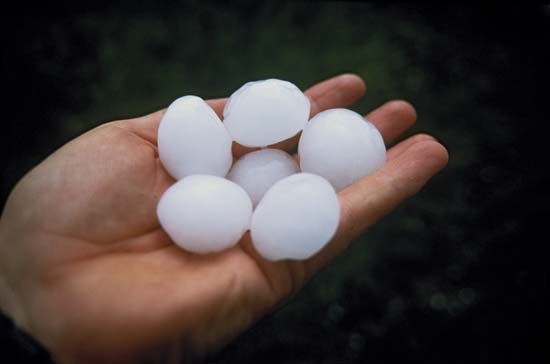hail
meteorology
precipitation of balls or pieces of ice with a diameter of 5 mm to 10 cm (about 0.2 to 4 inches). Small hail (also called sleet, or ice pellets) has a diameter of less than 5 mm. Because the formation of hail usually requires cumulonimbus or other convective clouds with strong updrafts, it often accompanies thunderstorms.
 Large hailstones are often characterized by alternating layers of clear and opaque ice, caused by irregular rates of freezing. In areas where the temperature is not far below 0° C (32° F), freezing occurs slowly, allowing trapped air to escape and producing clear ice. When the hailstone then moves into a much colder area, freezing occurs quickly, trapping air and producing a layer of white ice.
Large hailstones are often characterized by alternating layers of clear and opaque ice, caused by irregular rates of freezing. In areas where the temperature is not far below 0° C (32° F), freezing occurs slowly, allowing trapped air to escape and producing clear ice. When the hailstone then moves into a much colder area, freezing occurs quickly, trapping air and producing a layer of white ice.Hail is extremely destructive to buildings and crops; if large enough, it may be dangerous to animals exposed to it. Hailstones about 15 cm (6 inches) in diameter have fallen during thunderstorms in the Middle Western United States. Hailstorms are most common in the middle latitudes and usually last around 15 minutes. They ordinarily occur in middle to late afternoon. See also sleet.
- Louis-Alexandre, prince de Wagram Berthier
- Louis Althusser
- Louisa May Alcott
- Louis-Antoine de Bougainville
- Louis-Antoine de Bourbon Angoulême, duc d'
- Louis-Antoine de Bourbon, duc d' Angoulême
- Louis-Antoine de Noailles
- Louis-Antoine Fauvelet de Bourrienne
- Louis-Antoine Garnier-Pagès
- Louis-Antoine-Henri de Bourbon-Condé, Duke d' Enghien
- Louis-Antoine-Henri de Bourbon-Condé Enghien, Duke d'
- Louis-Antoine Ranvier
- Louis Aragon
- Louis-Armand de Lom d'Arce, baron de Lahontan
- Louis-Armand de Lom d'Arce Lahontan, baron de
- Louis-Armand I de Bourbon Conti, prince de
- Louis-Armand I de Bourbon, prince de Conti
- Louis-Armand II de Bourbon Conti, prince de
- Louis-Armand II de Bourbon, prince de Conti
- Louis Armstrong
- Louis Auchincloss
- Louis-Auguste de Bourbon, duc du Maine
- Louis-Auguste de Bourbon Maine, duc du
- Louis-Auguste-Victor Bourmont, Count de Ghaisnes de
- Louis-Auguste-Victor, Count de Ghaisnes de Bourmont